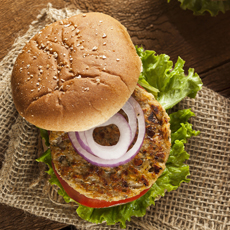TIP OF THE DAY: Sustainable Eating Helps All Of Us

|
You may have successfully conquered the first week of “good eating” in the new year. Congrats!
Now, can we twist your arm abut eating more sustainably? Here are recommendations from Chef Gerard Viverito, Director of Culinary Education for Passionfish, a NGO non-profit organization dedicated to educating people around the globe on the issue of sustainability in the seas. 1. Eat Less Meat & More Beans. Beans, lentils and other legumes are called “nitrogen “fixers.” They convert inert gas from the atmosphere into the type of ammonia needed for plant food, reducing the need to use as much synthetic nitrogen fertilizer. Livestock is a major driver of deforestation and loss of biodiversity. Livestock requires about 3.9 billion hectares of land for grazing and to produce animal feed. That’s an area that’s five times larger than Australia. Deforestation means fewer trees to absorb carbon dioxide, a greenhouse gas. Livestock emissions, including manure and digestive gas, contribute more greenhouse gas to the atmosphere than automobile emissions. Meatless Mondays is an idea that should evolve into Vegan Mondays. If you’re eating cheese and ice cream, it’s still part of the problem. With all the delicious vegan choices—including hearty vegetable stews, pasta, pizza and vegetarian chili—you won’t suffer one day a week. You may even discover new favorite dishes! Check out 16 main course bean dishes from Saveur. Yes, it can be more costly than other options, but American fisheries have some of the most stringent ecological rules in the world (and, might we add, health rules—no melamine in your shrimp). If we ate what the oceans were sustainably supplying instead of insisting on only a few well-known fish species, we would further cut down on over-fishing our waters. Be open to sampling different fish species. The new trend among top chefs is trash fish, a.k.a. rough fish. What are trash fish? Trash fish are those that travel in schools with more desirable fish, and are often landed as by-catch. Because they don’t have the marketing demand of other fish and thus only command a fraction of the price, fishermen would toss them overboard (trash them) as not worth the effort of processing. There is no standard list of trash fish. A fish that is considered trash in one region may be treasure in another. For example, the common carp is considered undesirable in the U.S. and Australia, but is the premier game fish of Europe and the most valuable food fish across most of Asia. Ask your fishmonger what’s available in your area. Just because you haven’t heard of something or it sounds weird, don’t pass it by. Dogfish travel in schools with flounder, hake and pollock, three of which have marketing value while the other is in the doghouse. In the U.S., 91% of all seafood consumed comes from outside the country. More than two-thirds of all seafood we eat comprises shrimp, salmon, tilapia (almost all farm-raised under dubious conditions) or canned tuna. The oceans offer a wealth of tasty fish, and we only eat four of them. Don’t walk away from banded rudderfish, barrel fish, bearded brotula, lionfish, southern stingray, squirrelfish and other strange names. If they didn’t taste good, they wouldn’t be for sale. Here’s more about trash fish. There’s even a sustainable fish cookbook—the first of many, no doubt. |
|
|
3. Use a sustainable cooking oil. It doesn’t make sense to buy healthy, sustainable foods and then cook them with oils made from genetically modified plants. Try the buttery Malaysian palm oil, which is natural and sustainably produced. Because it has a high smoke point, Malaysian palm oil can be used for grilling, baking and frying without burning and making food taste bad. All palm oil is non-GMO, which may be why it’s more affordable than the popular but non-GMO canola oil. Note: Be sure it’s Malaysian palm oil. The Malaysian government has commented to growing and processing. |
||
|
4. Upgrade your favorite spices to organic.
The use of chemical fertilizers and plant pesticides is a growing concern in the spice industry. But organic spices and herbs can be pricey, so invest in organic only for those that you use all the time. McCormick sells more than 22 organic herbs and spices—just about anything you need regularly, including vanilla extract. Here’s another money-saving tip: Whole ginger root is a fraction of the price of powdered. Buy a root and cut into 1-inch cubes then toss them into the freezer. Grate a cube whenever a recipe calls for this fragrant spice. Kale, spinach and other leafy greens grow quickly in most climates. This means they have a lower impact on our environment and may require less fertilizer than slower growing veggies. Up the kid-friendliness of these greens by making tasty oven-fried veggie chips. Drizzle oil (Malaysian sustainable palm oil, of course) over the greens, sprinkle with salt or other seasonings and then bake in a 350°F oven until slightly brown, about 10 to 12 minutes. Eat the crispy veggies for snacks, as pizza and pasta toppings, add to omelets, etc. This great microwave tray from Mastrad lets you make chips in two minutes! We stack them 3-4 trays high for the most chips in the shortest time. And of course, there are many, many luscious recipes for leafy greens. All you need to do is look online. To come full circle from the first tip, raising livestock takes a big toll on our environment. It uses more than 70% of our agricultural land and is the largest driver of deforestation (which enables greenhouse gases) in the world. |

|
|
|
But that doesn’t mean you have to give up meat if you want to eat sustainably. Just choose quality over quantity. When cooking, combine meat with healthy plant-based foods. Throw some black beans into ground beef when making tacos or combine chicken with quinoa when making a casserole. Eat as they do in the rest of the world: smaller portions of meat, larger portions of grains and vegetables. THANKS FOR HELPING Adopting even one of these six ideas will make an impact.
|
||



